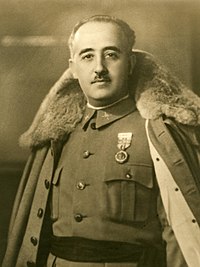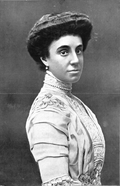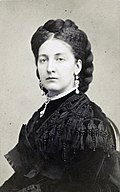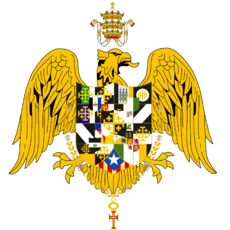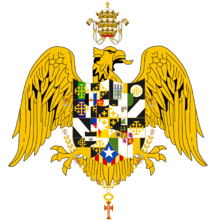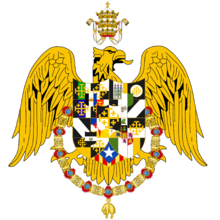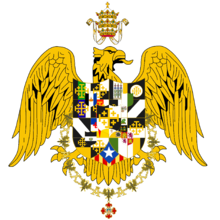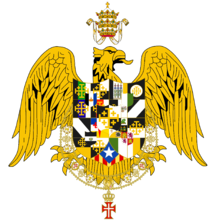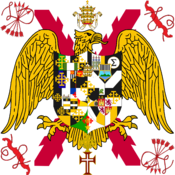Difference between revisions of "Romero I of Creeperopolis"
| Line 59: | Line 59: | ||
| embed = yes | | embed = yes | ||
| allegiance = {{flagdeco|Creeperopolis}} [[Catholic Imperial Restoration Council|Imperial Council]] | | allegiance = {{flagdeco|Creeperopolis}} [[Catholic Imperial Restoration Council|Imperial Council]] | ||
| − | | branch = {{flagdeco|Creeperopolis| | + | | branch = {{flagdeco|Creeperopolis|1326}} [[Creeperian Armed Forces|Romerist Armed Forces]] |
| rank = [[File:Coat of Arms of Creeperopolis.png|23px|link=Creeperian Armed Forces]] [[Creeperian Armed Forces|Commander-in-Chief]] | | rank = [[File:Coat of Arms of Creeperopolis.png|23px|link=Creeperian Armed Forces]] [[Creeperian Armed Forces|Commander-in-Chief]] | ||
| battles = | | battles = | ||
Revision as of 03:03, 16 January 2022
- "Saint Romero" and "San Romero" redirect here. For other uses, see Saint Romero (disambiguation) and San Romero (disambiguation).
- In this Creeperian name, the first or paternal surname is Martínez de Jiménez and the second or maternal family name is Galdámez de Águila.
| Romero I | |||||
|---|---|---|---|---|---|
| 9th Emperor of Creeperopolis and the Creeperans | |||||
| Reign | 2 January 1933 – 6 July 1946 | ||||
| Coronation | 15 September 1933 | ||||
| Predecessor | Adolfo IV | ||||
| Successor | Romero II | ||||
| Prime Minister(s) | Máximo Illescas Freixa | ||||
| 1st Supreme Caudillo of the Catholic Imperial Restoration Council | |||||
| Reign | 2 January 1933 – 6 July 1946 | ||||
| Predecessor | Position established | ||||
| Successor | Romero II | ||||
| 28th Holy Protector of the State of the Church | |||||
| Reign | 2 January 1933 – 6 July 1946 | ||||
| Predecessor | Adolfo III | ||||
| Successor | Romero II | ||||
| Supreme Pontiff | Pío XI (until 1939) Pío XII (from 1939) | ||||
| 6th Emperor of El Salvador | |||||
| Reign | 2 January 1933 – 6 July 1946 | ||||
| Predecessor | Adolfo II | ||||
| Successor | Romero II | ||||
| 28th King of Senvar | |||||
| Reign | 2 January 1933 – 6 July 1946 | ||||
| Predecessor | Adolfo II | ||||
| Successor | Romero II | ||||
| 11th Grand Prince of Creeperopolis | |||||
| Tenure | 3 June 1918 – 2 January 1933 | ||||
| Predecessor | Adolfo (II) Martínez Jiménez | ||||
| Successor | Romero (II) Martínez Guerrero | ||||
| Regent | Adolfo IV | ||||
| Born | 18 June 1899 San Salvador Imperial Palace, San Salvador, San Salvador, Creeperopolis | ||||
| Died | 6 July 1946 (aged 47) Lake San Salvador, north of San Salvador, Creeperopolis | ||||
| Burial | 15 September 1960 | ||||
| Consort | Adriana Guerrero Guillén (m. 1922; his death 1946) | ||||
| Issue | 5, including Romero II | ||||
| |||||
| House | House of Martínez – Pelayo | ||||
| Father | Adolfo IV of Creeperopolis | ||||
| Mother | Rafaela Galdámez Águila | ||||
| Religion | Creeperian Catholicism | ||||
| Signature |  | ||||
| Military service | |||||
| Allegiance | |||||
| Branch/service | |||||
| Rank | |||||
| Battles/wars | Creeperian Civil War | ||||
Romero I of Creeperopolis (Creeperian Script: Րոմերո Ի;[note 2] full name: Romero I Adolfo Carlos de San Alfonso y San Miguel Martínez de Jiménez y Galdámez de Águila;[note 3] 18 June 1899 – 6 July 1946) was the Emperor of Creeperopolis and the Creeperans, Holy Protector of the State of the Church, Emperor of El Salvador, and King of Senvar[note 4] from 1933 until his death in 1946.
The eldest son of Emperor Adolfo IV (reign: 1918–1933) and Empress Consort Rafaela Galdámez Águila, Romero I assumed the throne of Creeperopolis on 2 January 1933, however, his claim to the throne was contested by his younger brother, Prince Miguel. Both claimed the title of Emperor, with Romero I receiving political support from the right-wing Creeperian Conservative Coalition (CCC), while Miguel VII received political support from the left-wing People's Social Coalition (CSP). With the occurrence of a military skirmish in San Salvador del Norte between military factions supporting both claimants, both Romero I and Miguel VII accused the other of attacking first; calling upon the armed forces to rally to their side, the armed forces fractured in half along political ideological lines, beginning the Creeperian Civil War. Upon the beginning of the civil war, he established the Catholic Imperial Restoration Council (CRIC), more commonly referred to as simply the Imperial Council and informally referred to as the Romerists.
He married Adriana Guerrero Guillén and the couple had five children: Princess María, Princess Isabela, Grand Prince Romero (the future Emperor Romero II; reign: 1946–1976), Grand Prince José, and Princess Raquel. He was the grandfather of Emperors Adolfo V (reign: 1976–1987), Romero III (reign: 1987–1999), and Alfonso VI (reign: 1999–2003), and the great grandfather of reigning Emperor Alexander II (reign: 2003–present).
Since his death and the end of the civil war, Romero I has been revered by Creeperans as a hero to the Fatherland, being commonly known as Romero the Great.[note 5] In 1955, he was declared a martyr and beatified by Pope Pío XII, and in 1960, he was canonized as a saint by Pope Juan XXIII. Today, Romero I is most commonly referred to in Creeperopolis as San Romero.[note 6]
The right-wing ideology which he helped formulate, Romerism, has become the dominant political force in Creeperopolis. Adopted by the Creeperian Initiative (IRCCN y la'FPPU), Romerism has become the de facto political ideology of the country's government. As such, Romero I is revered as a national hero and a founding father of the current political system. Historians and political scientists have identified Romero I as one of the most important and influential political figures of the 20th century. The exact role and amount of power weilded by Romero I during his reign is a source of much debate, however, as several later historians have proposed that the military ultimately held national authority throughout his rule, beginning the modern dominance of the military in Creeperian politics.
Contents
Early life
Romero Adolfo Carlos de San Alfonso y San Miguel Martínez de Jiménez y Galdámez de Águila[1] was born on 18 June 1899 in the San Salvador Imperial Palace in San Salvador,[2] the capital city of Creeperopolis and the department of San Salvador.
He was baptized eight days after his birth on 26 June in the Cathedral of Christ the King in San Salvador by Archbishop José Viteri Ungo.[2] He was confirmed into the Creeperian Catholic Church on 15 September 1915 at the Cathedral of Christ the King in San Salvador at the age of sixteen by Archbishop Tomás Pineda Saldaña.[3]
His father was Prince Adolfo Martínez Jiménez and his mother was Princess Rafaela Galdámez Águila.[2] His uncles were Emperor Alexander I, who assumed the throne in 1898 following the death of Emperor Maximiliano II, and Grand Prince Alfonso Martínez Jiménez.[4] He was the great grandson of Emperor Adolfo III, and ultimately, a direct male-line descendant of Alfonso I, the first King of Creeperopolis[note 7] (reign: 1231–1264).[4]
Prince Romero was the second of five children, with his older sister being Princess María (born 1896) and his younger siblings being Prince Miguel (born 1901), Prince Alfonso (born 1903), and Princess Anastasia (born 1907).[5] At the time of his birth, he was fourth in line for the throne of Creeperopolis, after Grand Prince Alfonso, Prince Gustavo Martínez Dávalos, the son of Grand Prince Alfonso, and Prince Adolfo.[6] With the death of Emperor Alexander I on 10 March 1910, Prince Romero's next uncle and Alexander I's younger brother became Emperor Alfonso V.[7]
In 1917, Prince Romero began attendance of the San Salvador Imperial Military Academy to study military tactics and history.[8] He was reported to have excelled in his studies by Chief Field Marshal Jaime Cabañeras Zapata, the chairman of the military academy.[8] On 19 May 1918, his brother, Prince Alfonso, died to Creeperian Malaria at the age of fourteen, forcing Prince Romero to suspend his studies to attend his brother's funeral on 22 May.[9] Prince Alfonso's death reportedly caused Prince Romero's other brother, Prince Miguel, to question the Creeperian Catholic faith that his entire family, as well as much of the nation, adhered to,[10][11] while it reinforced Prince Romero's faith who believed that it was God's decision to allow Prince Alfonso to die to his illness and that he was in Heaven.[9] Romero I continuously stated throughout his reign that he believed that his brother was watching over him as his guardian angel, stated that he also prayed for his intercessions frequently throughout the civil war.[9]
Grand Prince
Ascension to Grand Prince
On 3 June 1918, Emperor Alfonso V died to Creeperian Malaria, and because his son and heir, Grand Prince Gustavo, died the previous year on 6 March 1917 in a hunting accident, Prince Romero's father became Emperor Adolfo IV.[12] Upon his father's ascension to Emperor, Prince Romero was elevated to the title of Grand Prince, heir apparent to the throne of Creeperopolis.[12] Alfonso V's death reportedly further increased Prince Miguel's questioning of religion in general, which eventually led him to denounce the Creeperian Catholic faith in 1920 and began to proclaim himself an atheist, the first time a member of the Creeperian royal family had ever became an atheist and the first to become an apostate Prince Roberto Martínez López converted to Senvarian Protestantism in 1620.[13][14] Grand Prince Romero was present at Alfonso V's funeral on 10 June, and was formally designated as Grand Prince and heir by his father on 15 September.[15]
After nearly three months away from the military academy, Grand Prince Romero returned to his studies in July 1918 and reportedly continued to excel in his studies.[16] Following his brother, Prince Miguel began attending the military academy in 1919 and the brothers helped each other in their studies during their time at the military academy.[17] While at the military academy, Grand Prince Romero observed military drills and training operations in San Salvador, San Miguel, Abdan, and the San Carlos Islands.[18] He studied both tactics and history for the army and navy while at the military academy.[16] He graduated from the military academy on 15 September 1920 with the honorary rank of Field Marshal and participated in Creeperopolis' annual military parade in San Salvador in celebration of the Day of the Creeperans.[19] Upon his graduation, his father bestowed upon him the Star of the Imperial Army.[20][21]
Introduction to politics
On 31 December 1921, Prime Minister Inhué Ordóñez Yepes had Grand Prince Romero preside over the session of the parliament, an extraordinary power of the Grand Prince, which is usually done by the Emperor, given upon his graduation from the military academy.[22] During the session, he was awarded the Order of the Parliament by Ordóñez Yepes, which was heavily protested by the Creeperian Socialist Party (PSC) and Creeperian Social Communist Party (PSCS), both allies of Ordóñez Yepes' National Liberal Party (PLN) and members of the People's Social Coalition (CSP).[21][23] The incident negatively affected Ordóñez Yepes' and the PLN's popularity among voters of the People's Social Coalition.[24] Ordóñez Yepes died in April 1922, and in the 1922 general election, the PLN lost twenty-six seats in the parliament, with voters voting instead largely for the PSC.[25][26] Additionally, the right-wing to far-right[27] Catholic Royalist Party (PRC) gained the most seats and its leader, Antonio Sáenz Heredia, became prime minister for a third term.[26][28]
Beginning on 31 December 1922, Sáenz Heredia made requests for Grand Prince Romero to attend sessions of the parliament along with Adolfo IV for ceremonial purposes.[29] He continued to attend sessions of the parliament throughout Sáenz Heredia's term as prime minister from 1922 through 1927.[30] Outside of attending sessions of parliament at the request of Sáenz Heredia, Grand Prince Romero generally stayed out of Creeperopolis' political affairs.[31]
Following the Christmas Putsch of 1923, Grand Prince Romero condemned the actions of the Creeperian Pro-Fatherland Front (FPPC) and the Camisas Negras (CN) for attempting to overthrow the government.[32][33] Similarly, following the San Pedro Incident of 1925, he condemned the actions of the Action Party for San Pedro (PASP) for attempting to overthrow the departmental government of San Pedro.[34][35] He also denounced the violence occurring between the Camisas Negras, the Falange Creeperiano (FC), and the Atheist Red Army (ERA), which has come to be known as the Reigns of Terrors,[36] calling for the demobilization of the paramilitary groups and a peaceful resolution, which was ignored by the three belligerents.[37]
Prior to the 1927 general election, Grand Prince Romero became more vocal about his support for the Creeperian Conservative Coalition (CCC), and especially the Catholic Royalist Party, of which he was a member of,[38][39] by attending Sáenz Heredia's political campaign rallies and publicly endorsing the Catholic Royalist Party.[40] On the contrary, his brother, Prince Miguel, began vocally supporting the People's Social Coalition and the Creeperian Social Communist Party, alienating him from the rest of the royal family and gaining him the support of the CSP in return.[41] Some socialists and communists opposed Prince Miguel's support due to their anti-monarchal positions, while many others accepted his support, seeing it as a means to the eventual abolition of the Creeperian monarchy.[42][43] During the election, the Creeperian Socialist Party won thirty-one seats in the parliament, defeating the Catholic Royalist Party by one seat.[44][45] The party's leader, Édgar Cazalla Beldad, became prime minister on 31 December 1927.[46][45]
Crisis of 1928
In January 1928, Cazalla Beldad, who was the first ever member of the Creeperian Socialist Party to serve as prime minister, began efforts to implement socialist economic reforms,[47] blaming the poor socioeconomic status of the majority of Creeperian workers on the economic policies of Sáenz Heredia and Macos Espiga Mina (prime minister: 1892–1902) as intentionally "keeping down" the working class.[48][49] The People's Social Coalition passed the Act to Protect the Workers of Creeperopolis on 3 January by a 51–49 vote, which mandated that all businesses in Creeperopolis had to pay their workers a wage of two pesos per hour,[note 8] give their workers at least two weeks of paid vacation, and prohibited the use of corporal punishment or withholding pay as a disciplinary punishment.[50][51] While Grand Prince Romero held some objections to some aspects of the reforms, while agreeing with other aspects,[52] the Creeperian Conservative Coalition and several of Creeperopolis' largest corporations and monopolies vehemently opposed the reforms.[53] The deadline for the implementation of the reforms was 3 March 1928, exactly two months after the bill was passed.[54]

In an effort to prevent the enforcement of the bill, Gustavo López Dávalos, the CEO of the National Coffee and Sugar Corporation (CORNACA), hired militants from the Camisas Negras to assassinate Cazalla Beldad.[55] On 7 February, a month after the bill passed, three militants of the Camisas Negras, wearing Atheist Red Army uniforms, stormed the parliament and assassinated Cazalla Beldad by shooting him while he was delivering a speech.[56] The assassins fought with police officers immediately dispatched to the parliament to control the situation, and during the chaos, Sáenz Heredia declared himself as acting prime minister and declared that all of the laws passed by Cazalla Beldad were null and void.[57] The People's Social Coalition protested and condemned Sáenz Heredia's power grab, demanding his immediate resignation, which he eventually did on 10 February following a parliamentary vote to appoint a new prime minister.[58] Grand Prince Romero condemned the violence, stating that "this sort of violence leads to the fall of governments."[59]
Joel Lacasa Campos, a member of the Creeperian Social Communist Party, was elected to replace Sáenz Heredia as prime minister.[60] His selection was condemned by the Creeperian Conservative Coalition, which demanded his immediate resignation.[61] On 23 February, Lacasa Campos had the Atheist Red Army assassinate López Dávalos in revenge for the assassination of Cazalla Beldad.[62] In revenge of López Dávalos's assassination, Sáenz Heredia had the Falange Creeperiano assassinate Lacasa Campos and the family of Cayetano Handel Carpio, the leader of the Atheist Red Army, on 1 March.[63] Throughout the month of March, the Atheist Red Army, Falange Creeperiano, and Camisas Negras all engaged in street battles to intimidate the opposition and voters, and said street battles usually came under suppression from the Civil Police or the Creeperian Army.[64]
Grand Prince Romero was deeply concerned and distraught by the violence occurring within the first half of 1928.[65] He reportedly told one of the royal family's servants that he was afraid to speak out and publicly condemn the violence, as he feared alienating the Creeperian Conservative Coalition and increasing the hostility of the People's Social Coalition by making any public condemnations.[66] He has referred to the Crisis of 1928 as the "worst scar in the history of Creeperian democracy."[67] During the civil war, he made remarks stating that he had been praying during the height of the Crisis of 1928 that the political climate in the country become calm for when he inevitably becomes Emperor of Creeperopolis.[67]
Buildup to civil war
With the assumption of Tobías Gaos Nores as prime minister on 2 March and the end of martial law in San Salvador on 19 April, a general sense of peace came upon Creeperian politics, however, tensions between far-left and far-right extremists remained present, with various paramilitary groups continuing to patrol the streets to intimidate voters and opponents.[68] Several politicians, military officials, members of the royal family, including Grand Prince Romero,[69] and many civilians believed that the unfolding violence was a prelude and leading to a larger, politically divisive, nation-wide civil war.[70]
In the years following the Crisis of 1928, the amount of street violence between paramilitaries and attacks against politicians decreased with an increased police and military presence in major Creeperian cities,[71] however, when the Creeperopolis national football team lost 4–0 to Tirol during the semifinals of the 1932 Terraconservan Cup, a series of riots erupted in, forcing the tournament's final to be held in Adolfosburg.[72] Additionally, earlier that year in July, Gaos Nores died to Creeperian Malaria, however, some historians have argued that he committed suicide due to his involvement in a corruption scandal involving the Ministry of the Treasury.[73][74] José Pardo Barreda, the minister of the treasury, was also implicated in the scandal, however, he denied any involvement, and accused Adolfo IV and Grand Prince Romero of conspiring to ruin his and Gaos Nores' reputations.[74][75]
The football riots, political scandal, and previous political violence heavily affected the result of the 1932 general election, leading to a decisive victory for the center-right National Conservative Party (PCN), winning 41 seats.[76] Máximo Illescas Freixa assumed the position of prime minister on 31 December, succeeding Jorge Meléndez Ramírez of the Creeperian Socialist Party who served out the remainder of Gaos Nores' term.[77] Illescas Freixa swore that during his administration, "law and order would be restored to the Fatherland" and "peace will once again return to normality."[77]
Reign as Emperor and civil war
Succession crisis
In mid-December 1932, Emperor Adolfo IV and Empress-Consort Rafaela both fell ill with Creeperian Malaria and both remained in the San Salvador Imperial Palace to rest and recover from the illness.[78][79] Although Empress-Consort Rafaela managed to make a full recovery by the end of December, Adolfo IV's condition continued to worsen.[78] His doctors were unable to improve his condition, and on 2 January 1933, three days after the beginning of Illescas Freixa's term as prime minister, Adolfo IV succumbed to his illness at 9:02 a.m. in the San Salvador Imperial Palace.[78][80]
His death was publicly announced at 10 a.m. by Jorge Gómez Figueroa, the lead physician for the Creeperian royal family, at the Cathedral of Christ the King, and he announced that Grand Prince Romero would succeed his father as Emperor, assuming the name of Romero I.[81][82] Romero I was first notified of his father death and his own ascension to the title of Emperor at 10:30 a.m. by his mother, a priest, and some servants.[83] Romero I accepted the title, and at noon, he gave a short speech at the San Salvador Imperial Palace stating his intentions to help Creeperopolis "heal and move forward" from its recent past of violence.[84]
Despite Romero I's assumption as Emperor, the People's Social Coalition, who had seen Romero I as a far-right radical, officially announced that they refused to recognize Romero I as Emperor at 1 p.m.[85] Half an hour later, Prince Miguel, who had by now fully aligned himself with the People's Social [86]Coalition, declared himself to be the legitimate Emperor of Creeperopolis and that Romero I was attempting to usurp his title.[86][87] He began referring to himself as Emperor Miguel VII, and the People's Social Coalition subsequently announced their recognition of Miguel VII's claim to the throne of Creeperopolis.[88][89]
With both claimants to the throne now feeling insecure about their claim, both Romero I and Miguel VII ordered the immediate arrest of the other and called upon the armed forces to not align themselves with the other.[90][91] Illescas Frexia announced that the parliament recognized Romero I as the legitimate Emperor of Creeperopolis, however, the People's Social Coalition continued to refuse to recognize Romero I, instead, continuing to recognize Miguel VII.[92] Because of the orders given by both claimants, the Creeperian Armed Forces effectively fractured into two factions, those supporting Romero I's claim and those supporting Miguel VII's claim.[93] With tensions high, both military factions began attempting to secure territory in preparation for a perceived inevitable civil war and war of succession, however, both factions were ordered by their respective Emperors to not attack each other.[94]
One such location where both military factions attempted to secure territory was in the city of San Salvador del Norte, where at 7:23 p.m., both factions encountered each other attempting to secure the primary military barracks in the city.[95] At 7:25 p.m., a shot was heard by both sides, and immediately, both, disregarding their Emperor's orders to not engage, began attacking the other.[96] The ensuing skirmish ended in a victory for the soldiers aligned with Miguel VII, while those loyal to Romero I retreated and secured control of the city's capitol building.[96] It remains unknown to this day who fired the first shot, but nonetheless, the skirmish at San Salvador del Norte began the Creeperian Civil War, which almost every Creeperian politician had sought to desperately avoid.[97][98]
In the wake of the skirmish, both sides ordered their loyal soldiers to begin preparations to fight for their Emperor, with Romero I establishing the Catholic Imperial Restoration Council (CRIC) and Miguel VII establishing the National Council for Peace and Order (CNPO), other wise known as the Imperial Council and National Council, or more informal, the Romerists and the Miguelists.[98][99] Both councils composed of soldiers divided along partisan political lines, with soldiers loyal to Romero I and the Imperial Council generally being right-wing monarchists, conservatives, Catholics, falangists, and fascists, while soldiers loyal to Miguel VII and the National Council generally being left-wing republicans, liberals, atheists and the non-religious, socialists, and communists, with some support from racial and ethnic minorities in the country.[100]
Unstable early rule
Beginning of the De-Catholization
War in the early 1940s
Siege of San Salvador
Personal life
Marriage

Romero I married Adriana Guerrero Guillén, the daughter of Antonio Guerrero Menéndez, the Captain General of San Salvador at the time, on 1 March 1922.[101] He was 22 years old and she was 21 years old.[101] The marriage ceremony occurred in the San Salvador Imperial Palace, with the ceremony being presided over by Pineda Saldaña.[102] Several prominent politicians were in attendance, including Adolfo IV, Ordóñez Yepes, Sáenz Heredia, Guerrero Menéndez, and Pío XI.[103]
The marriage was arranged as a political reward to Guerrero Menéndez for supporting Sáenz Heredia during his second term as prime minister, and to ensure his continued support during his third term as prime minister.[104] The arrangement and effective political bribe was controversial at the time, with various politicians of the People's Social Coalition denouncing the marriage as a corrupt political favor, however, the controversy has since been disregarded and considered a "non-issue" by subsequent Creeperian historians.[105]
Issue
Romero I and Empress Consort Adriana had five children, four of whom survived to adulthood, and one of whom, Romero II Óscar Fidel de San Alfonso y San Miguel Martínez de Galdámez y Guerrero de Guillén, succeeded Romero I as Emperor of Creeperopolis and the Creeperans, Holy Protector of the State of the Church, Emperor of El Salvador, and King of Senvar.[106] Through his children, Romero I had nineteen grandchildren, although, only one was born during his lifetime.[107] His most notable great grandchild is Alexander II, the current reigning Emperor of Creeperopolis, through Romero II and Alfonso VI.[29]
| Name | Portrait | Lifespan | Marriage | Issue |
|---|---|---|---|---|
| Princess María Claudia Martínez Guerrero de Hernández |
8 March 1924 – 8 January 2008 (aged 83) |
Prince Rodolfo Alberto Hernández Dávalos (m. 1943–1993) |
Prince Alfonso Princess Guadeloupe Prince Romero Princess Carmen | |
| Princess Isabela Juana Martínez Guerrero |
29 October 1927 – 3 August 1945 (aged 17) |
N/A | ||
| Emperor Romero II Óscar Martínez Guerrero [note 9] |
18 September 1930 – 11 November 1976 (aged 46) |
Empress Consort María Fátima Escobar Gutiérrez de Martínez (m. 1950–1976) |
Princess Anastasia Emperor Adolfo V Emperor Romero III Emperor Alfonso VI Princess María Princess Cassandra | |
| Grand Prince José Alexander Martínez Guerrero [note 10] |
3 February 1932 – 3 July 1992 (aged 60) |
Princess Angelina María Ramírez López de Martínez (m. 1954–1992) |
Princess Rubí Princess Leonora | |
| Princess Raquel Alexandra Martínez Guerrero de Mendoza |
23 December 1938 – living (age 85) |
Prince Carlos Alexander Mendoza Fuentes (m. 1960–2011) |
Prince Cristóbal Princess Verónica Princess Gabriela Prince Antonio Prince Adolfo Princess Xihomara Princess Yolanda | |
| Shortened form of names listed (given name, middle name, paternal surname, maternal surname, marital name). | ||||
Claims of illegitimate children
Due to the importance of Romero I in modern Creeperian history, several individuals have publicly claimed to be illegitimate children of Romero I, born to a different mother from Empress Consort Adriana.[108] During the 1950s, 1960s, and 1970s, around 50 to 60 individuals who publicly claimed to be illegitimate children of Romero I were arrested, tortured, and sentenced to prison by the Creeperian government.[109] All of the known individuals arrested for claiming to be illegitimate descendants of Romero I were charged will blasphemy and committing Mal'l Rey, both of which are capital offenses and punishable by death.[110]
Ideology
| Part of a series on |
| Romerism |
|---|
 |
| Categories: |
Politically, Romero I was a member of Catholic Royalist Party, a right-wing to far-right political party,[27] from 1921 until his death in 1946.[38] Upon his ascension as Emperor, he became the fifth consecutive Emperor to be a member of the Catholic Royalist Party,[111] although, he did initially consider joining the center-right National Conservative Party.[22] He opposed the far-right Creeperian Pro-Fatherland Front since its attempt to overthrow the government in 1923,[31] however, he began to tolerate the party with the beginning of the civil war in 1933.[112][113]
Romero I was an absolute monarchist, a Catholic theocrat, a National Catholic,[27][38] a social conservative, and vehemently anti-communist and anti-atheist. His exact economic positions are disputed, however, it is generally agreed upon by historians that Romero I generally aligned himself with right-wing and capitalist economics before the civil war,[22] while during the civil war, he had the government take control of virtually all aspects of the economy as a part of the war effort.
Death, state funeral, and burial
Operation Destroy Everything

Private funeral and burial
State funeral burial

Sainthood
Emperor, Saint, & Martyr Romero I | |
|---|---|
| Emperor of Creeperopolis and the Creeperans | |
| Venerated in | Creeperian Catholic Church |
| Beatified | 6 July 1955, San Pedro's Basilica, San Salvador del Oeste, State of the Church by Pope Pío XII |
| Canonized | 15 September 1960, San Pedro's Basilica, San Salvador del Oeste, State of the Church by Pope Juan XXIII |
| Major shrine | Valley of the Fallen |
| Feast | 30 September |
| Attributes | Imperial garments, Crown of Creeperopolis |
| Patronage | Creeperopolis, Creeperian Catholics, San Salvador, Monarchy of Creeperopolis, martyred Catholics, oppressed and persecuted Catholics |
| Controversy | War crimes, crimes against humanity, White Terror, human rights abuses, concentration camps |
| Influences | Alfonso I, Miguel I, Carlos III, Martyrs of the Creeperian Civil War |
| Influenced | Martyrs of the Creeperian Civil War, Romero Galdámez Alas |
Efforts for canonization
Controversies
War crimes
Crimes against humanity and human rights abuses
Use of concentration camps
Legacy
Commemoration
In propaganda
Things named after Romero I
- Buildings and infrastructure
- Emperor San Romero Suspension Bridge
- Saint Romero I Adolfo Martínez Galdámez International Airport
- Torre Emperador Romero I
- Military units
 The 14th Creeperian Army is nicknamed the Ejército de Emperador San Romero I (translated as the Army of Emperor Saint Romero I).
The 14th Creeperian Army is nicknamed the Ejército de Emperador San Romero I (translated as the Army of Emperor Saint Romero I). The 33rd Creeperian Army is nicknamed the Ejército de Romeristos (translated as the Army of Romerists).
The 33rd Creeperian Army is nicknamed the Ejército de Romeristos (translated as the Army of Romerists).- The 1st Infantry Battalion is nicknamed the Batallón de San Romero (translated as the Battalion of Saint Romero).[note 11]
- Settlements
- Emperador San Romero I, Deltino
- San Romero, Abdan
- San Romero, Adolfosburg
- San Romero, Castilliano
- San Romero, San Carlos Islands
- San Romero, San Salvador
- San Romero, San Salvador del Norte
- San Romero, Zapatista
The city of San Romero, and the department of San Romero, have often been erroneously attributed to be named after Romero I. The city of San Romero was established in 712AD and given the name "San Romero" in 1258, being named after Saint Romero of Al-Kifal who was martyred by the Caliphate of Deltino in 1234 during the Creeperian Crusade. Likewise, the department was renamed after the same Saint Romero in 1258.
- Universities
- Emperor San Romero University
- San Romero I University, Adolfosburg
- San Romero I University, Chalatenango
- San Romero I University, Pasadena
- San Romero I University, San Luís
- San Romero I University, San Romero
- San Romero I University, San Salvador
In popular culture
Film
Literature
- The 2009 book Guerra Civil by Orlando Pareja Palau covers and outlines the events of the Creeperian Civil War.
- The 2013 book La'De-Catolización by Pareja Palau covers and outlines the events of the De-Catholization.
- The 2016 book San Romero I by Pareja Palau covers and outlines the events of Romero I's life.
Titles, styles, honors, and arms
Titles and styles
| Royal styles of Romero I of Creeperopolis | |
|---|---|
| Reference style | His Imperial Majesty |
| Spoken style | Your Imperial Majesty |
| Alternative style | Sir |
Romero I's complete title as Emperor was:[114]
"By the Grace of the Lord, our God, Romero I Adolfo Carlos de San Alfonso y San Miguel Martínez de Jiménez y Galdámez de Águila, Emperor of Creeperopolis and the Creeperans, Emperor of all Catholics, Imperial Commander-in-Chief of the Imperial Army of Creeperopolis, Imperial Commander-in-Chief of the Imperial Naval Forces of Creeperopolis, Imperial Commander-in-Chief of the Imperial Air Forces of Creeperopolis, Imperial Commander-in-Chief of the Imperial Guard of Creeperopolis, Holy Protector of the State of the Church, Emperor of El Salvador, King of Senvar, Archduke of Abdan, Archduke of Adolfo III Land, Archduke of Adolfosburg, Archduke of Helam, Archduke of Jakiz, Archduke of La'Libertad, Archduke of La'Unión, Archduke of Salvador, Archduke of the San Carlos Islands, Archduke of San Luís, Archduke of San Miguel, Archduke of San Pedro, Archduke of San Romero, Archduke of San Salvador, Archduke of San Salvador del Norte, Archduke of Santa Ana, Archduke of Senvar, Archduke of Sonsatepan, Archduke of Zapatista, Duke of Puerto Francisco, Presider of the Parliament of the Fatherland."
Awards and decorations
- Creeperian decorations[21]
 Grand Master and 19th Knight of the Imperial Order of the Papal and Creeperian Cross
Grand Master and 19th Knight of the Imperial Order of the Papal and Creeperian Cross Grand Cross of the Imperial Cross of San Romero the Martyr (6 July 1987)[note 12]
Grand Cross of the Imperial Cross of San Romero the Martyr (6 July 1987)[note 12] Grand Master of the Imperial Order of Miguel the Great
Grand Master of the Imperial Order of Miguel the Great Grand Master of the Imperial Cross of Alfonso the Great
Grand Master of the Imperial Cross of Alfonso the Great Grand Master of the Imperial Order of Manuel the Great
Grand Master of the Imperial Order of Manuel the Great Grand Master of the Imperial Order of Felipe the Saint
Grand Master of the Imperial Order of Felipe the Saint Grand Master of the Imperial Order of Fidel the Martyr
Grand Master of the Imperial Order of Fidel the Martyr Grand Master of the Imperial Cross of Carlos the Martyr
Grand Master of the Imperial Cross of Carlos the MartyrGrand Master of the Imperial Order of the Fatherland
 Grand Master of the Imperial Order of Valor and Bravery
Grand Master of the Imperial Order of Valor and BraveryGrand Cross of the Imperial Order of Romerism (15 September 1950)[note 12]
 Grand Master of the Star of the Imperial Army (x3)
Grand Master of the Star of the Imperial Army (x3) Grand Master of the Star of the Imperial Navy
Grand Master of the Star of the Imperial Navy Grand Master of the Star of the Imperial Air Force
Grand Master of the Star of the Imperial Air Force Grand Master of the Star of the Imperial Guard
Grand Master of the Star of the Imperial Guard 1st Class Member of the Cross of Saint Romero I (15 September 1950)[note 12]
1st Class Member of the Cross of Saint Romero I (15 September 1950)[note 12] Grand Master of the Order of the Crusaders' Cross (x2)
Grand Master of the Order of the Crusaders' Cross (x2) Grand Master of the Order of José Delgado León
Grand Master of the Order of José Delgado León Grand Master of the Order of the Star of the White Rose
Grand Master of the Order of the Star of the White Rose Grand Master of the Order of the Golden Star's Cross
Grand Master of the Order of the Golden Star's Cross Grand Master of the Order of the Revolution of 1833
Grand Master of the Order of the Revolution of 1833Grand Master of the Cross of Adolfo I
 Grand Master of the Cross of Salvador III
Grand Master of the Cross of Salvador III Grand Collar of the Order of the Catholic Royalist Party (25 December 1949)[note 12]
Grand Collar of the Order of the Catholic Royalist Party (25 December 1949)[note 12] Member of the Order of the Parliament (31 December 1921)
Member of the Order of the Parliament (31 December 1921)
- Foreign national decorations[115]
 Grand Cross of the Order of the Fatherland (3 October 1935)
Grand Cross of the Order of the Fatherland (3 October 1935) Grand Cross of the Order of José the Great (3 October 1935)
Grand Cross of the Order of José the Great (3 October 1935)
 Grand Cross of the Order of the Castillianan Eagle (1 April 1937)
Grand Cross of the Order of the Castillianan Eagle (1 April 1937)
 Grand Master of the Order of Service to the Fatherland (2 January 1933)
Grand Master of the Order of Service to the Fatherland (2 January 1933)
 Grand Collar of the Order of the Lyoan Kingdom (1 January 1938)
Grand Collar of the Order of the Lyoan Kingdom (1 January 1938)
 1st Class Member of the Containment of the Communist Menace (20 July 1946)[note 12]
1st Class Member of the Containment of the Communist Menace (20 July 1946)[note 12]
 Grand Cross of the Supreme Order of Christ (3 January 1933)
Grand Cross of the Supreme Order of Christ (3 January 1933) Grand Cross of the Order of the Papal Star (3 January 1933)
Grand Cross of the Order of the Papal Star (3 January 1933) Grand Cross of the Order of the Sacred Cross (15 September 1918)
Grand Cross of the Order of the Sacred Cross (15 September 1918) Grand Cross of the Order of Saint Romero I (15 September 1961)[note 12]
Grand Cross of the Order of Saint Romero I (15 September 1961)[note 12]
 1st Class Member of the Order of the Yourtanadian Republic (20 June 1943)
1st Class Member of the Order of the Yourtanadian Republic (20 June 1943)
- Foreign dynastic decorations[115]
 Knight of the Distinguished Order of the Red Eagle (3 March 1933)
Knight of the Distinguished Order of the Red Eagle (3 March 1933)
 Grand Collar of the Order of Santiago Matadeltinianos (1 April 1937)
Grand Collar of the Order of Santiago Matadeltinianos (1 April 1937)
Military ranks
 Field Marshal; 15 September 1920[19]
Field Marshal; 15 September 1920[19] Commander-in-Chief of the Imperial Army; 2 January 1933 – 6 July 1946
Commander-in-Chief of the Imperial Army; 2 January 1933 – 6 July 1946 Commander-in-Chief of the Imperial Navy; 2 January 1933 – 6 July 1946
Commander-in-Chief of the Imperial Navy; 2 January 1933 – 6 July 1946 Commander-in-Chief of the Imperial Air Force; 2 January 1933 – 6 July 1946
Commander-in-Chief of the Imperial Air Force; 2 January 1933 – 6 July 1946 Commander-in-Chief of the Imperial Guard; 2 January 1933 – 6 July 1946
Commander-in-Chief of the Imperial Guard; 2 January 1933 – 6 July 1946
Arms
| Coat of Arms of Romero I[116] | |||
|---|---|---|---|
Imperial Order of the Papal and Creeperian Cross |
Imperial Order of Miguel the Great |
Imperial Cross of Alfonso the Great |
Supreme Order of Christ |
Ancestry
| House of Martínez – Pelayo |
|---|
| Counts of Extremadura |
| Emirs of Rabadsun |
| Kings of Creeperopolis |
| Emperors of Creeperopolis |
| Disputed reigns |
| Ancestors of Romero I of Creeperopolis[117] |
|---|
See also
- Five Great Monarchs
- Alfonso I of Creeperopolis (1231–1264)
- Miguel I of Creeperopolis (1301–1365)
- Manuel III of Creeperopolis (1770–1783)
- Adolfo III of Creeperopolis (1833–1887)
Notes
- ↑ Originally buried in the Cathedral of Christ the King on 25 December 1949.
- ↑ Creeperian Spanish pronunciation: [ˈro.me.ɾo(-l) priˈme.ɾo].
- ↑ Creeperian Script: Րոմերո Ի Ադոլֆո Ծարլոս դե Սան Ալֆոմսո յ Սան Միգփել Մարտձնեզ դե Ջիմէմեզ յ Գալդըմեզ դե Ըգփիլա.
- ↑ Reigned as: Römer I of Senvar (Senvarian form of Romero); Senvarian pronunciation: [ˈrœm̩.ɛʁ deːʁ ˈtsvaɪ.tɛ].
- ↑ Creeperian Spanish – Creeperian: Րոմերո'լ Գրամդե; Creeperian Spanish – Iberic: Romero'l Grande; Creeperian Spanish pronunciation: [ˈro.me.ɾo-l ˈgran.de].
- ↑ Creeperian: Սան Րոմերո; Creeperian Spanish for: Creeperian Spanish pronunciation: [san ˈro.me.ɾo]; Saint Romero.
- ↑ Alfonso I used the title King of the Creeperans, with "King of Creeperopolis" being a subsequent reference.
- ↑ This was considered extremely high for the time, as the average worker could expect to earn only one peso per day.
- ↑ Grand Prince: 2 January 1933 – 6 July 1946; succeeded Romero I to the crowns of Creeperopolis, the State of the Church, El Salvador, and Senvar; reigned 6 July 1946 – 11 November 1976.
- ↑ Grand Prince: 6 July 1946 – 9 March 1962.
- ↑ The 1st Infantry Battalion is a part of the Black Division (1st Infantry Division), the elite forces of the Creeperian Army.
- ↑ 12.0 12.1 12.2 12.3 12.4 12.5 Posthumously awarded.
References
Citations
- ↑ Pareja Palau 2016, p. iii.
- ↑ 2.0 2.1 2.2 Pareja Palau 2016, p. 1.
- ↑ Pareja Palau 2016, p. 10.
- ↑ 4.0 4.1 Pareja Palau 2016, p. 2.
- ↑ Pareja Palau 2016, p. 3.
- ↑ Pareja Palau 2016, p. 7.
- ↑ Pareja Palau 2016, p. 8.
- ↑ 8.0 8.1 Pareja Palau 2016, p. 11.
- ↑ 9.0 9.1 9.2 Pareja Palau 2016, p. 12.
- ↑ Pareja Palau 2009, p. 14.
- ↑ Pareja Palau 2013, p. 4.
- ↑ 12.0 12.1 Pareja Palau 2016, p. 14.
- ↑ Pareja Palau 2009, p. 17.
- ↑ Pareja Palau 2013, p. 7.
- ↑ Pareja Palau 2016, p. 16.
- ↑ 16.0 16.1 Pareja Palau 2016, p. 18.
- ↑ Pareja Palau 2016, pp. 18–21.
- ↑ Pareja Palau 2016, p. 19–20.
- ↑ 19.0 19.1 Pareja Palau 2016, pp. 21–22.
- ↑ Pareja Palau 2016, p. 23.
- ↑ 21.0 21.1 21.2 Pareja Palau 2016, p. 422.
- ↑ 22.0 22.1 22.2 Pareja Palau 2016, p. 25.
- ↑ Pareja Palau 2016, pp. 25–27.
- ↑ Pareja Palau 2016, p. 27.
- ↑ Pareja Palau 2016, pp. 27–30.
- ↑ 26.0 26.1 Pareja Palau 2009, pp. 23–24.
- ↑ 27.0 27.1 27.2 Ramírez Ortega 2006, pp. 23–24.
- ↑ Pareja Palau 2016, p. 30.
- ↑ 29.0 29.1 Pareja Palau 2016, p. 37.
- ↑ Pareja Palau 2016, pp. 37–43.
- ↑ 31.0 31.1 Pareja Palau 2016, p. 38.
- ↑ Pareja Palau 2009, pp. 24–25.
- ↑ Pareja Palau 2016, p. 39.
- ↑ Pareja Palau 2009, p. 25.
- ↑ Pareja Palau 2016, p. 41.
- ↑ Pareja Palau 2009, pp. 23–26.
- ↑ Pareja Palau 2016, pp. 41–42.
- ↑ 38.0 38.1 38.2 Pareja Palau 2016, p. 24.
- ↑ Ussía López 1996, p. 4.
- ↑ Pareja Palau 2016, p. 43.
- ↑ Pareja Palau 2016, pp. 43–44.
- ↑ Pareja Palau 2009, p. 28.
- ↑ Ussía López 1996, p. 6.
- ↑ Pareja Palau 2009, pp. 28–30.
- ↑ 45.0 45.1 Ussía López 1996, p. 7.
- ↑ Pareja Palau 2009, p. 30.
- ↑ Pareja Palau 2009, p. 31.
- ↑ Pareja Palau 2009, p. 32.
- ↑ Ussía López 1996, p. 8.
- ↑ Pareja Palau 2009, pp. 33–34.
- ↑ Ussía López 1996, pp. 14–19.
- ↑ Pareja Palau 2016, p. 46.
- ↑ Ussía López 1996, pp. 22–24.
- ↑ Ussía López 1996, p. 25.
- ↑ Ussía López 1996, pp. 29–35.
- ↑ Ussía López 1996, p. 42.
- ↑ Ussía López 1996, p. 43.
- ↑ Ussía López 1996, pp. 43–55.
- ↑ Pareja Palau 2016, p. 53.
- ↑ Ussía López 1996, p. 55.
- ↑ Ussía López 1996, pp. 55–61.
- ↑ Ussía López 1996, p. 87.
- ↑ Ussía López 1996, p. 112.
- ↑ Ussía López 1996, pp. 115–149.
- ↑ Pareja Palau 2016, p. 56.
- ↑ Pareja Palau 2016, pp. 56–58.
- ↑ 67.0 67.1 Pareja Palau 2016, p. 57.
- ↑ Ussía López 1996, pp. 147–154.
- ↑ Pareja Palau 2016, p. 60.
- ↑ Ussía López 1996, pp. 152–153.
- ↑ Ussía López 1996, pp. 163–164.
- ↑ Ussía López 1996, p. 180.
- ↑ Ussía López 1996, p. 172.
- ↑ 74.0 74.1 Pareja Palau 2016, p. 62.
- ↑ Ussía López 1996, p. 173.
- ↑ Pareja Palau 2016, p. 65.
- ↑ 77.0 77.1 Pareja Palau 2016, p. 66.
- ↑ 78.0 78.1 78.2 Pareja Palau 2009, p. 37.
- ↑ Pareja Palau 2016, p. 67.
- ↑ Pareja Palau 2016, p. 69.
- ↑ Pareja Palau 2009, p. 38.
- ↑ Pareja Palau 2016, pp. 70–72.
- ↑ Pareja Palau 2016, p. 72.
- ↑ Pareja Palau 2016, p. 74–76.
- ↑ Pareja Palau 2016, p. 77.
- ↑ 86.0 86.1 Pareja Palau 2009, p. 39.
- ↑ Pareja Palau 2016, p. 79.
- ↑ Pareja Palau 2009, p. 40.
- ↑ Pareja Palau 2016, pp. 79–81.
- ↑ Pareja Palau 2009, p. 42.
- ↑ Pareja Palau 2016, p. 83.
- ↑ Pareja Palau 2009, p. 43.
- ↑ Pareja Palau 2009, p. 45.
- ↑ Pareja Palau 2009, pp. 45–46.
- ↑ Pareja Palau 2009, p. 47.
- ↑ 96.0 96.1 Pareja Palau 2009, p. 48.
- ↑ Pareja Palau 2009, p. 50.
- ↑ 98.0 98.1 Pareja Palau 2016, p. 87.
- ↑ Pareja Palau 2009, p. 51.
- ↑ Pareja Palau 2009, pp. 51–55.
- ↑ 101.0 101.1 Pareja Palau 2016, p. 32.
- ↑ Pareja Palau 2016, pp. 32–33.
- ↑ Pareja Palau 2016, p. 33.
- ↑ Pareja Palau 2016, p. 34.
- ↑ Pareja Palau 2016, pp. 34–35.
- ↑ Pareja Palau 2016, p. 36.
- ↑ Pareja Palau 2016, pp. 36–37.
- ↑ Castaño Gil 1999, pp. 3–9.
- ↑ Castaño Gil 1999, pp. 15–43.
- ↑ Castaño Gil 1999, p. 93.
- ↑ Pareja Palau 2016, pp. 24–25.
- ↑ Pareja Palau 2016, p. 58.
- ↑ Pareja Palau 2009, p. 35.
- ↑ Pareja Palau 2016, p. v.
- ↑ 115.0 115.1 Pareja Palau 2016, p. 423.
- ↑ Pareja Palau 2016, pp. iii–iv.
- ↑ Pareja Palau 2016, p. A1.
Bibliography
- Castaño Gil, Federico Armando (12 April 1999). Լոս'Իլեգձտիմոս [The Illegitimates]. The Creeperian Civil War (in Creeperian Spanish). II (3 ed.). San Salvador, Creeperopolis: Impresión Creeperiano. ISBN 9780803207943. Retrieved 16 December 2021.CS1 maint: unrecognized language (link)
- Pareja Palau, Orlando Óscar (1 May 2009). Written at San Romero, Creeperopolis. Գփերրա Ծիվիլ [Civil War]. History of the Fatherland (in Creeperian Spanish). I (2 ed.). San Salvador, Creeperopolis: Impresión Creeperiano. ISBN 978-0-8330-4159-3. Retrieved 20 November 2021.CS1 maint: unrecognized language (link)
- Pareja Palau, Orlando Óscar (1 February 2013). Written at San Romero, Creeperopolis. Լա'Դե-Ծատօլիզածիօն [The De-Catholization]. History of the Fatherland (in Creeperian Spanish). I (2 ed.). San Salvador, Creeperopolis: Impresión Creeperiano. ISBN 978-0-19-928357-6. Retrieved 20 November 2021.CS1 maint: unrecognized language (link)
- Pareja Palau, Orlando Óscar (15 September 2016). Written at San Romero, Creeperopolis. Սան Րոմերո Ի [Saint Romero I]. Monarchs of the Fatherland (in Creeperian Spanish). II (2 ed.). San Salvador, Creeperopolis: Impresión Creeperiano. ISBN 9780803207943. Retrieved 20 November 2021.CS1 maint: unrecognized language (link)
- Ramírez Ortega, Alexander Gustavo (15 September 2006). Իդեոլոգիաս դե լա'Պատրիա [Ideologies of the Fatherland] (in Creeperian Spanish). I (1 ed.). San Salvador, Creeperopolis: Ministry of Internal Affairs. ISBN 978-0-299-09804-9. Retrieved 25 November 2021.CS1 maint: unrecognized language (link)
- Ussía López, José Alexander (4 March 1996). Լա'Ծրիսիս դե 1928 [The Crisis of 1928] (in Creeperian Spanish). I (2 ed.). San Salvador, Creeperopolis: Impresión Creeperiano. ISBN 0-312-33801-5. Retrieved 8 December 2021.CS1 maint: unrecognized language (link)
Further reading
- Pareja Palau, Orlando Óscar (1 September 1998). Written at San Romero, Creeperopolis. Հիստորիա դե Ծատօլիծիսմո [History of Catholicism]. History of the Fatherland (in Creeperian Spanish). II (1 ed.). San Salvador, Creeperopolis: Impresión Creeperiano (published 25 December 1998). ISBN 0-7864-0612-7. Retrieved 20 November 2021.CS1 maint: unrecognized language (link)
External links
- Media related to Romero I of Creeperopolis at LCNWiki
- St. Romero I of Creeperopolis (NSIndex; last edited 5 October 2019), by Creeperopólis
- St. Romero I of Creeperopolis (IIWiki; last edited 31 January 2020) by Creeper
- Romero I of Creeperopolis (Wayback Machine archive of LCNWiki; 12 May 2021)
Romero I of Creeperopolis Cadet branch of the House of Martínez – Ishmael Born: 18 June 1899 Died: 6 July 1946
| ||
| Regnal titles | ||
|---|---|---|
| Preceded by Adolfo IV |
Emperor of Creeperopolis and the Creeperans 1933–1946 |
Succeeded by Romero II |
| Preceded by Adolfo III |
Holy Protector of the State of the Church 1933–1946 | |
| Preceded by Adolfo II |
Emperor of El Salvador 1933–1946 | |
| King of Senvar 1933–1946 | ||
| Creeperian royalty | ||
| Preceded by Adolfo II |
Grand Prince of Creeperopolis 1918–1933 |
Succeeded by Romero II |
| Political offices | ||
| New office | Supreme Caudillo of the Catholic Imperial Restoration Council 1933–1946 |
Succeeded by Romero II |
| Military offices | ||
| Preceded by Adolfo IV |
Commander-in-Chief of the Armed Forces 1933–1946 |
Succeeded by Romero II |
| Honorary titles | ||
| Preceded by Adolfo II |
Presider of the Parliament 1933–1946 |
Succeeded by Romero II |
- Articles containing Spanish-language text
- Articles with short description
- Use dmy dates from November 2021
- Use Jackian from November 2021
- Articles with invalid date parameter in template
- All LCNWiki articles written in Jackian
- Pages with broken file links
- CS1 maint: unrecognized language
- CS1 location test
- Romero I of Creeperopolis
- Romerism
- 1899 births
- 1946 deaths
- Creeperopolis
- Creeperopolis RP
- Creeperopolis Terraconserva
- Terraconserva
- Creeperian Monarch
- Emperors of Creeperopolis
- Holy Protectors of the State of the Church
- Emperors of El Salvador
- Kings of Senvar
- Grand Princes of Creeperopolis
- Creeperian Civil War
- Creeperian Conflicts
- Creeperian Military Figure
- Military officer
- Saint
- Recipients of the Imperial Order of the Papal and Creeperian Cross
- Recipients of the Imperial Cross of San Romero the Martyr
- Recipients of the Imperial Order of Miguel the Great
- Recipients of the Imperial Cross of Alfonso the Great
- Recipients of the Imperial Order of Manuel the Great
- Recipients of the Imperial Order of Felipe the Saint
- Recipients of the Imperial Order of Fidel the Martyr
- Recipients of the Imperial Cross of Carlos the Martyr
- Recipients of the Imperial Order of the Fatherland (Creeperopolis)
- Recipients of the Imperial Order of Valor and Bravery
- Recipients of the Imperial Order of Romerism
- Recipients of the Star of the Imperial Army
- Recipients of the Star of the Imperial Navy
- Recipients of the Star of the Imperial Air Force
- Recipients of the Star of the Imperial Guard
- Recipients of the Cross of Saint Romero I
- Recipients of the Order of the Crusaders' Cross
- Recipients of the Order of José Delgado León
- Recipients of the Order of the Star of the White Rose
- Recipients of the Order of the Golden Star's Cross
- Recipients of the Order of the Revolution of 1833
- Recipients of the Cross of Adolfo I
- Recipients of the Cross of Salvador III
- Recipients of the Order of the Catholic Royalist Party
- Recipients of the Order of the Parliament (Creeperopolis)
- Recipients of the Order of the Red Eagle


